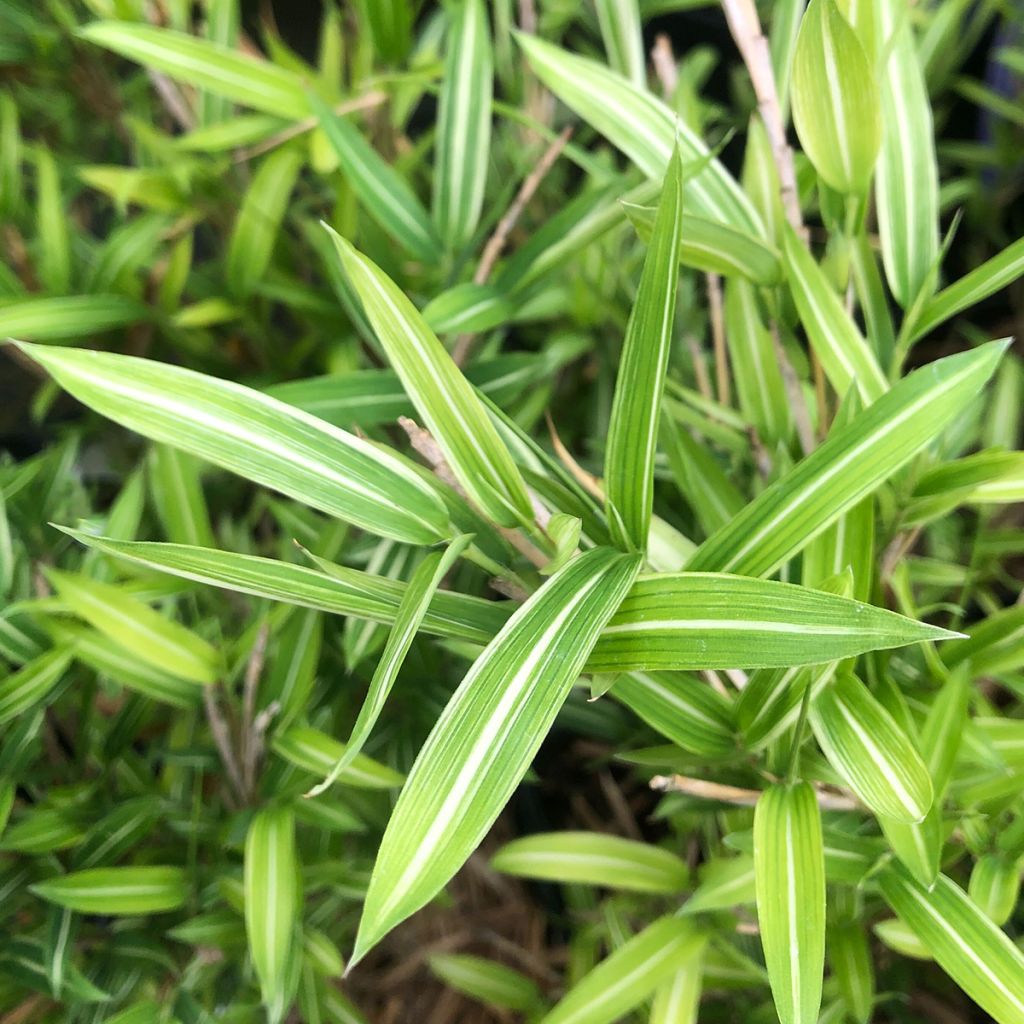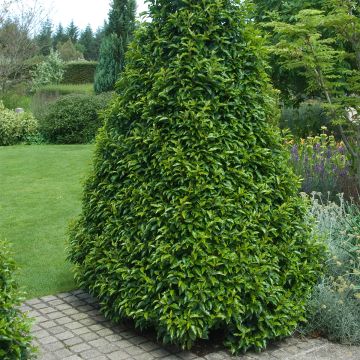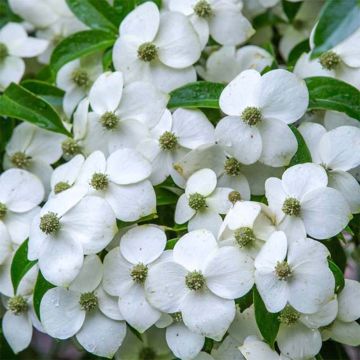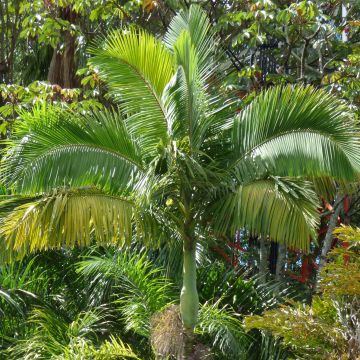

Pleioblastus shibuyanus Tsuboï - Petit bambou panaché


Pleioblastus shibuyanus Tsuboï - Petit bambou panaché


Pleioblastus shibuyanus Tsuboï - Petit bambou panaché
Pleioblastus shibuyanus Tsuboï - Dwarf Bamboo
Pleioblastus shibuyanus Tsuboï
Tsuboi Bamboo, Dwarf white-striped Bamboo 'Tsuboii'
This item cannot be shipped to the selected country
Delivery charge from €5.90
More information
Schedule delivery date,
and select date in basket
This plant carries a 24 months recovery warranty
More information
We guarantee the quality of our plants for a full growing cycle, and will replace at our expense any plant that fails to recover under normal climatic and planting conditions.
From €5.90 for pickup delivery and €6.90 for home delivery
Express home delivery from €8.90.
Does this plant fit my garden?
Set up your Plantfit profile →
Description
Pleioblastus shibuyanus Tsuboi (also marketed under the names Pleioblastus argenteostriatus 'Tsuboi', Pleioblastus shibuyanus 'Tsuboii', Phyllostachys shibuyanus 'Tsuboi') is a dwarf bamboo with beautiful very bright, variegated foliage of green and white-cream. It is quite tall for a Pleioblastus, measuring 1.5m (5ft) to 2m (7ft) at maturity. Vigorous, erect, but dense, it has abundant foliage that is more striped with white in the sun, but its brightness is more enhanced in partial shade. This creeping variety can form superb ground covers or long low borders, the height of which can be controlled by pruning and expansion by adding a bamboo root barrier. In the ground or in pots, it allows for dense screens that catch the light. Evergreen and cold-resistant, it thrives in any good, preferably non-calcareous, moist garden soil.
Pleioblastus shibuyanus Tsuboi is an upright and bushy bamboo with moderate growth. Perfectly suited to harsh winters, it is a form with variegated foliage of a species native to Japan. Like all bamboos, it belongs to the grass family Poaceae. This bamboo has thin, hollow canes which are pale green in colour, with a diameter of 2 to 5 mm (1in). It reaches up to 1.5m (5ft), or even 2m (7ft), in height. The plant spreads more or less slowly through its trailing rhizomes over a distance of about 3.5m (11ft) on the ground. The canes branch into slender, long, and upright branches, adorned with numerous medium-sized leaves. Its evergreen foliage is very dense. It consists of pubescent leaves on both sides, measuring 12 to 18 cm (5 to 7in) long and 2 to 4 cm (1 to 2in) wide. They are light green, more or less streaked with white-cream, a colour that is accentuated when the plant is exposed to the sun. This bamboo is well-suited for pruning, which further enhances its natural elegance.
Perfectly hardy and vigorous, this bamboo thrives in all situations, but prefers the sun as well as deep and moist soil. It works well in borders, as groundcovers, in partial shade, in a small hedge, or even in a pot on the patio or balcony. Its invasive nature requires the installation of bamboo root barriers to contain its growth. With a real elegance, it is perfectly suited for zen, Japanese, exotic, or contemporary gardens. It can be associated with other non-aggressive bamboos such as Fargesia (Fargesia denudata, Fargesia rufa, Fargesia murielae). It can also create a dense and luminous hedge, along a pathway in a large garden or planted in large containers on a balcony. This bamboo responds well to pruning and is well-suited to container gardening, provided that the older canes are regularly removed to make room for new shoots.
Report an error about the product description
Pleioblastus shibuyanus Tsuboï - Dwarf Bamboo in pictures


Plant habit
Foliage
Botanical data
Pleioblastus
shibuyanus
Tsuboï
Poaceae
Tsuboi Bamboo, Dwarf white-striped Bamboo 'Tsuboii'
East Asia
Other Pleioblastus
Planting and care
Pleioblastus is an undemanding bamboo, but it prefers a deep, fertile acidic to neutral soil, which is not too dry and is without excess limestone. Install it in a sunny location to accentuate the variegation of its foliage, or in a partially shaded position in hot and sunny regions. It should preferably be planted in late summer or autumn, or even in spring. It is strongly recommended, when planting, to install a bamboo root barrier to limit its spread. Perfectly hardy, it can withstand temperatures as low as -22°C (1°F). In the ground, it can tolerate moderate drought once established. For container cultivation, use well-draining potting compost and provide organic fertilizer twice a year to prevent leaf yellowing due to excess water and lack of nutrients. Propagation can be done through rhizome cuttings or dividing clumps. This bamboo can be pruned every year in early spring to encourage the development of entirely new foliage or to give it a particular shape.
Planting period
Intended location
Care
This item has not been reviewed yet - be the first to leave a review about it.
Evergreen shrubs
Haven't found what you were looking for?
Hardiness is the lowest winter temperature a plant can endure without suffering serious damage or even dying. However, hardiness is affected by location (a sheltered area, such as a patio), protection (winter cover) and soil type (hardiness is improved by well-drained soil).

Photo Sharing Terms & Conditions
In order to encourage gardeners to interact and share their experiences, Promesse de fleurs offers various media enabling content to be uploaded onto its Site - in particular via the ‘Photo sharing’ module.
The User agrees to refrain from:
- Posting any content that is illegal, prejudicial, insulting, racist, inciteful to hatred, revisionist, contrary to public decency, that infringes on privacy or on the privacy rights of third parties, in particular the publicity rights of persons and goods, intellectual property rights, or the right to privacy.
- Submitting content on behalf of a third party;
- Impersonate the identity of a third party and/or publish any personal information about a third party;
In general, the User undertakes to refrain from any unethical behaviour.
All Content (in particular text, comments, files, images, photos, videos, creative works, etc.), which may be subject to property or intellectual property rights, image or other private rights, shall remain the property of the User, subject to the limited rights granted by the terms of the licence granted by Promesse de fleurs as stated below. Users are at liberty to publish or not to publish such Content on the Site, notably via the ‘Photo Sharing’ facility, and accept that this Content shall be made public and freely accessible, notably on the Internet.
Users further acknowledge, undertake to have ,and guarantee that they hold all necessary rights and permissions to publish such material on the Site, in particular with regard to the legislation in force pertaining to any privacy, property, intellectual property, image, or contractual rights, or rights of any other nature. By publishing such Content on the Site, Users acknowledge accepting full liability as publishers of the Content within the meaning of the law, and grant Promesse de fleurs, free of charge, an inclusive, worldwide licence for the said Content for the entire duration of its publication, including all reproduction, representation, up/downloading, displaying, performing, transmission, and storage rights.
Users also grant permission for their name to be linked to the Content and accept that this link may not always be made available.
By engaging in posting material, Users consent to their Content becoming automatically accessible on the Internet, in particular on other sites and/or blogs and/or web pages of the Promesse de fleurs site, including in particular social pages and the Promesse de fleurs catalogue.
Users may secure the removal of entrusted content free of charge by issuing a simple request via our contact form.
The flowering period indicated on our website applies to countries and regions located in USDA zone 8 (France, the United Kingdom, Ireland, the Netherlands, etc.)
It will vary according to where you live:
- In zones 9 to 10 (Italy, Spain, Greece, etc.), flowering will occur about 2 to 4 weeks earlier.
- In zones 6 to 7 (Germany, Poland, Slovenia, and lower mountainous regions), flowering will be delayed by 2 to 3 weeks.
- In zone 5 (Central Europe, Scandinavia), blooming will be delayed by 3 to 5 weeks.
In temperate climates, pruning of spring-flowering shrubs (forsythia, spireas, etc.) should be done just after flowering.
Pruning of summer-flowering shrubs (Indian Lilac, Perovskia, etc.) can be done in winter or spring.
In cold regions as well as with frost-sensitive plants, avoid pruning too early when severe frosts may still occur.
The planting period indicated on our website applies to countries and regions located in USDA zone 8 (France, United Kingdom, Ireland, Netherlands).
It will vary according to where you live:
- In Mediterranean zones (Marseille, Madrid, Milan, etc.), autumn and winter are the best planting periods.
- In continental zones (Strasbourg, Munich, Vienna, etc.), delay planting by 2 to 3 weeks in spring and bring it forward by 2 to 4 weeks in autumn.
- In mountainous regions (the Alps, Pyrenees, Carpathians, etc.), it is best to plant in late spring (May-June) or late summer (August-September).
The harvesting period indicated on our website applies to countries and regions in USDA zone 8 (France, England, Ireland, the Netherlands).
In colder areas (Scandinavia, Poland, Austria...) fruit and vegetable harvests are likely to be delayed by 3-4 weeks.
In warmer areas (Italy, Spain, Greece, etc.), harvesting will probably take place earlier, depending on weather conditions.
The sowing periods indicated on our website apply to countries and regions within USDA Zone 8 (France, UK, Ireland, Netherlands).
In colder areas (Scandinavia, Poland, Austria...), delay any outdoor sowing by 3-4 weeks, or sow under glass.
In warmer climes (Italy, Spain, Greece, etc.), bring outdoor sowing forward by a few weeks.

















































